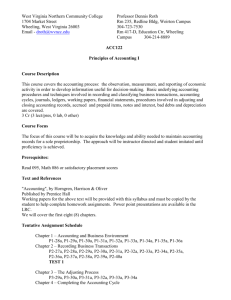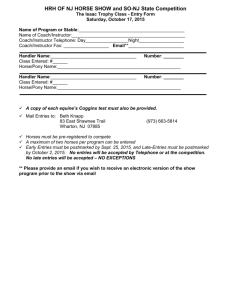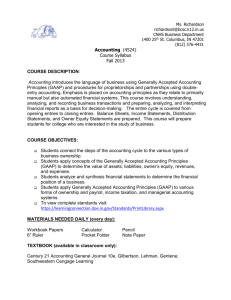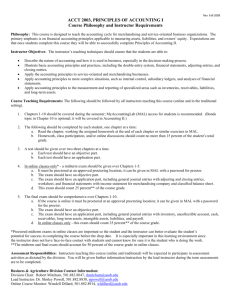Document 10289797
advertisement
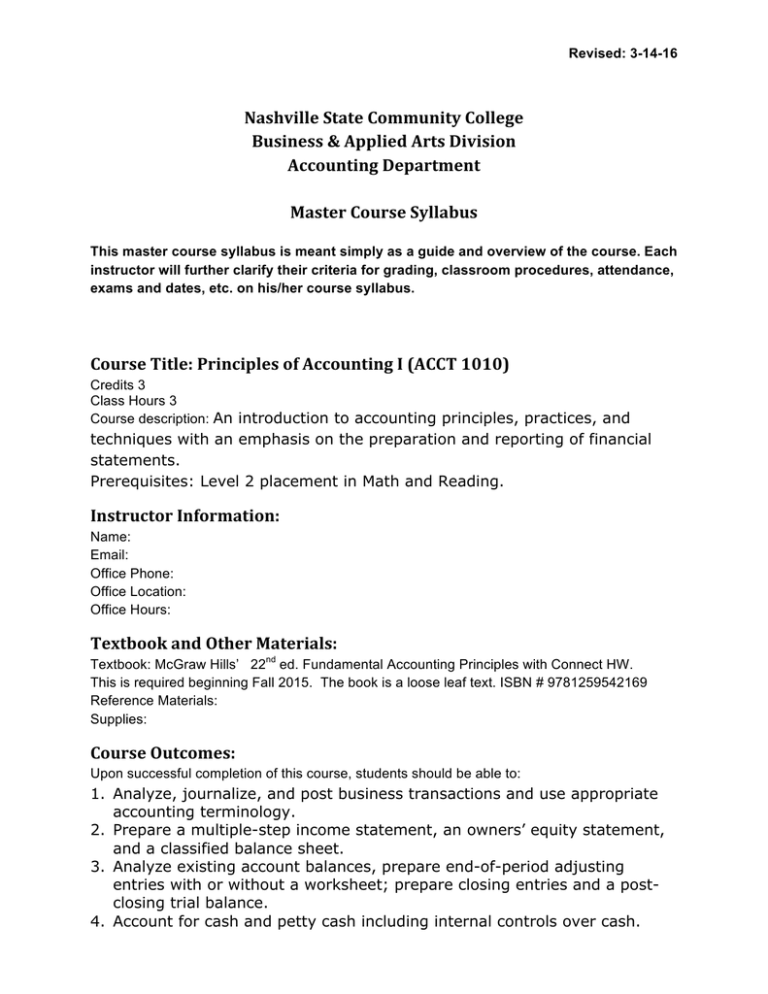
Revised: 3-14-16 Nashville State Community College Business & Applied Arts Division Accounting Department Master Course Syllabus This master course syllabus is meant simply as a guide and overview of the course. Each instructor will further clarify their criteria for grading, classroom procedures, attendance, exams and dates, etc. on his/her course syllabus. Course Title: Principles of Accounting I (ACCT 1010) Credits 3 Class Hours 3 Course description: An introduction to accounting principles, practices, and techniques with an emphasis on the preparation and reporting of financial statements. Prerequisites: Level 2 placement in Math and Reading. Instructor Information: Name: Email: Office Phone: Office Location: Office Hours: Textbook and Other Materials: Textbook: McGraw Hills’ 22nd ed. Fundamental Accounting Principles with Connect HW. This is required beginning Fall 2015. The book is a loose leaf text. ISBN # 9781259542169 Reference Materials: Supplies: Course Outcomes: Upon successful completion of this course, students should be able to: 1. Analyze, journalize, and post business transactions and use appropriate accounting terminology. 2. Prepare a multiple-step income statement, an owners’ equity statement, and a classified balance sheet. 3. Analyze existing account balances, prepare end-of-period adjusting entries with or without a worksheet; prepare closing entries and a postclosing trial balance. 4. Account for cash and petty cash including internal controls over cash. 2 5. Account for merchandising companies including costing and internal control over inventory. 6. Account for receivables; plant assets, natural resources and intangibles; current liabilities and payroll accounting. Course Competencies: The following are detailed course competencies intended to support the course outcomes: 1. 2. 3. 4. 5. 6. 7. 8. 9. 10. 11. 12. 13. 14. 15. 16. 17. 18. 19. 20. 21. 22. 23. 24. Identify the type of account and the normal balance for that account. Prepare in proper format, a journal entry to record the transaction in the general journal or special journal. Prepare, in proper format, an income statement, owner’s equity statement, and balance sheet. Demonstrate the impact of a business transaction on the accounting equation. Complete a worksheet for a service company. List and describe each step in the accounting cycle. Prepare adjusting entries. Identify permanent (real) or temporary (nominal) accounts. Record closing entries, and prepare a post-closing trial balance. Prepare appropriate journal entries. Complete a worksheet for a merchandising company. Complete in good format each of the financial statements for a merchandising firm. Prepare closing entries for a merchandising firm. Compute ending inventory and cost of goods sold under various cost flow methods. Prepare a bank reconciliation and required journal entries. Establish, reconcile, reimburse, and either increase or decrease a petty cash fund and record required journal entries. Identify appropriate internal controls for accounting data. Calculate the amount of bad debts expense and make appropriate journal entries using the various methods. Make journal entries to record the receipt of a note, accrual of interest revenue, and collection of the note at maturity. Record lump-sum purchases, individual purchases, depreciation using the various methods, disposals and trades of fixed assets. Record the purchase and subsequent depletion or amortization of the asset. Record the payroll and the employer’s related payroll tax expense. Make journal entries to record the making of a note, accrual of interest expense, and payment of the note at maturity. Record journal entries to accrue warranty expense and subsequent warranty claims. 3 The following are general education competencies intended to support the course outcomes: 1. Know how to locate, evaluate, and use information sources. 2. Apply mathematical concepts to problems and situations. 3. Use critical thinking skills. Topics to Be Covered: • • • • • • Chapter 1: Purpose and importance of accounting, users and uses of accounting, opportunities in accounting and related fields, why ethics are crucial to accounting, generally accepted accounting principles, the accounting equation, analyzing business transactions using the accounting equation, computing and interpreting return on assets, identifying and preparing financial statements. Chapter 2: Steps in the accounting process, source documents and their purposes, accounts and their use, ledger and chart of accounts, use of debits and credits and their role in double-entry accounting, impact of transactions on accounts and financial statements, computing debt ratio and its use in analyzing company performance, recording transactions in the journal and posting to the ledger, preparing and using a trial balance, preparing financial statements. Chapter 3: Periodic reporting and time period principle, accrual accounting, types of adjustments and their purpose, how adjustments link to financial statements, computing and using profit margin to analyze company performance, preparing an adjusted trial balance, and preparing financial statements from an adjusted trial balance. Chapter 4: Temporary and permanent accounts, steps in the accounting process, classified balance sheet, computing and using current ratio to assess a company's financial position, preparing a worksheet, preparing closing entries, preparing a post-closing trial balance. Chapter 5: Merchandising activities, perpetual and periodic inventory systems, computing and using acid-test ratio to assess liquidity, computing and using gross margin ratio to assess profitability, analyzing and recording transactions for merchandise purchases and sales using a perpetual system, preparing adjustments and closing accounts for a merchandising company, preparing a multiple-step and single-step income statement. Chapter 6: Identifying costs of merchandise inventory, analyzing the effects of inventory methods for both financial and tax reporting, 4 analyzing the effects of inventory errors, assessing inventory management using both inventory turnover and days' sales in inventory, computing inventory using specific identification, FIFO, LIFO, and weighted average methods. • • • • • Chapter 7: Journalizing and posting transactions using special journals, preparing and proving the accuracy of subsidiary ledgers. Chapter 8: Defining internal control and its purpose and principles, cash and cash equivalents, control features of banking activities, computing and using days' sales uncollected to assess liquidity, applying internal controls to cash receipts and disbursements, recording petty cash fund transactions, preparing a bank reconciliation. Chapter 9: Accounts receivable and notes receivable, calculating maturity date and interest, computing and using accounts receivable turnover to assess financial condition, applying direct write-off and allowance methods to receivables, estimating uncollectible accounts based on sales and accounts receivable, recording the receipt of a note, recording the honoring or dishonoring of a note and adjustments for interest. Chapter 10: Depreciating plant assets, analyzing alternative depreciation methods, computing asset turnover, distinguishing between revenue and capital expenditures, accounting for asset disposal, accounting for natural resources and intangible assets. Chapter 11: Current and long-term liabilities, contingent liabilities, computing times interest earned, preparing entries to account for short-term notes payable, preparing entries to record employee and employer payroll deductions or expenses and liabilities, preparing entries for estimated liabilities. Course Assessments: Exams, homework, possible projects and class participation may all be used in assessing the students’ performance, knowledge and skills. Grading Policy See individual Instructor for Weight placed to each assignment, and number of exams as these may vary. 5 Grading Scale: A 90-­‐100% B 80-­‐89% C 70-­‐79% D 65-­‐69% F 00-­‐64% Make-­‐up procedures for missed assignments and work. See Individual Instructor. Attendance Policy A student is expected to attend all scheduled classes and laboratories. Each instructor will formulate an attendance policy and provide it on the course syllabus. Absences are counted from the first scheduled meeting of the class, and it is the responsibility of each student to know the attendance policy of each instructor in whose class he/she is enrolled. If a student is absent from a class, he/she should give an advanced explanation to the instructor. Absences in a course may affect a student’s final grade. The student is responsible for all assigned work in the course regardless of excused or unexcused absences. Tardiness may also affect a student’s final grade. Failure to attend class will result in a final course grade of “FA” or “FN” (see explanation below) depending on the individual instructor’s course policy. FA= failure, attendance-related (unofficial withdrawal) Last recorded date of attendance required. FN= failure, never attended class (unofficial withdrawal) Student Communication Channels It is the student’s responsibility to check D2L and MyNSCC email on a regular basis. These are the official communication channels between the college and students. Students are responsible for the information communicated through those channels. D2L contains specific course information and MyNSCC contains information important for other purposes. Please note that Early Warning Alerts do not affect a student’s academic standing. 6 ADA Compliance Statement Nashville State complies with the Americans with Disabilities Act. If you wish to request any special accommodations for any courses in which you are enrolled, contact the Student Disabilities Office at 353.3721. Classroom Misconduct Nashville State Community College has a zero tolerance policy for disruptive conduct in the classroom. Students whose behavior disrupts the classroom will be subject to disciplinary sanctions. Please consult your Student Handbook for more specific details. The instructor has primary responsibility for control over classroom behavior and maintenance of academic integrity. He/she can order temporary removal or exclusion from the classroom of any student engaged in disruptive conduct or in conduct which violates the general rules and regulations of the College. Disruptive behavior in the classroom may be defined as, but is not limited to, behavior that obstructs or disrupts the learning environment (e.g., offensive language, harassment of students and professors, repeated outbursts from a student which disrupt the flow of instruction or prevent concentration on the subject taught, failure to cooperate in maintaining classroom decorum, etc.), the continued use of any electronic or other noise or light emitting device which disturbs others (e.g., disturbing noises from beepers, cell phones, palm pilots, lap-top computers, games, etc.). Please be aware that children are not allowed in class or unattended on campus. Academic Dishonesty (Honor Code) Any form of academic dishonesty, cheating, plagiarizing, or other academic misconduct is prohibited. “Plagiarism may result from: (1) failing to cite quotations and borrowed ideas, (2) failing to enclose borrowed language in quotation marks, and (3) failing to put summaries and paraphrases in your own words (A Writer’s Reference 331). Academic dishonesty may be defined as, but is not limited to, intentionally trying to deceive by claiming credit for the work of another person, using information from a web page or source without citing the reference, fraudulently using someone else’s work on an exam, paper, or assignment, recycling your own work from another course, purchasing papers or materials from another source and presenting them as your own, attempting to obtain exams/materials/assignments in advance of the date of administration by the instructor, impersonating someone else in a testing situation, providing confidential test information to someone else, submitting the same assignment in two different classes without requesting both instructor’s permission, allowing someone else to copy or use your work, using someone else’s work to complete your own, altering documents, transcripts or grades, and forging a faculty/staff member’s signature. In addition to other possible disciplinary sanctions that may be imposed through regular college procedures as a result of academic dishonesty the instructor has the authority to assign an “F” or a “Zero” for the exercise, paper, or examination or to assign an “F” for the course. Students may appeal through the appropriate college grade appeal procedures. 7 Inclement Weather Policy In the event of an inclement weather event, check the Nashville State web site home page at www.nscc.edu for announcements on campus closures. Campus closures will also be announced on local television stations (channels 2, 4, 5, and 17). When classes are cancelled, an online assignment will be posted in NS Online. Check your NS Online email for a message from your instructor regarding your online assignment requirements. Even though classes may be cancelled, some areas, i.e. Testing Center, may be open. However, you should check before commuting to campus. The Vice President for Academic Affairs and the Director of Security are responsible for cancellation decisions during an inclement weather event for the Nashville State main campus and the Southeast campus. Cookeville, Waverly, and Dickson Campus Directors will make class cancellation decisions based on conditions in their respective areas. Decisions about class cancellations are based on actual conditions, not forecasts. The perspective used for making decisions is that of the college as an employer, not as a K-12 institution. Students should use their own best judgment in determining whether to report to campus during inclement weather when classes are not cancelled.
